Where in the world did the winter go?!
It’s March, my friends! Collegiate racing on the Schuylkill starts in less than two weeks and the first of high school racing soon follows. The elite community has U.S. selection increasingly on the brain and masters athletes who have taken it indoors are eagerly getting back in the boat. Personally, I’m days away from heading south for training—not to mention much-anticipated sun!!—with plans to return home for NSR1 in April.
No doubt, spring is just about here along with its flurry of training camps, racing and travel!
Navigating Nutrition and Travel
I’m asked a lot of questions about nutrition and travel, and know well that eating on the road can be a powerful source of stress and frustration. We understand that what we eat affects how we feel, and naturally want to feel at our best before we set out to perform (more on this point later). Additionally, some of us have weigh-ins to consider to boot!
Take a look at the note I received from one mom after her daughter raced Head of the Charles:
One other thing she wanted to talk to you about was what you do for meals when traveling for regattas. She’s a pretty healthy eater and has her routine on race day. She was a little stressed in Boston because she didn’t have control over where and what they were eating, and I think she psyched herself out a little. I’m sure you have to deal with this and can maybe give her tips or a plan for next time she has to travel.
How many of you athletes relate?!
Ironically, this year’s Head of the Charles tested my own travel stamina and skill. I raced the Champ Double, which meant that I didn’t need to weigh-in (win!). But I’d committed to racing in lightweight events during the next two consecutive weekends. At minimum, this meant that I needed to stay within striking distance of 59kg while navigating the round trip drive to Boston, one night with a host family, and two in a hotel equipped with a mini-fridge but no other options for food prep.
Reality Check
Travel as an athlete is inevitable. It’s also a fun and rewarding part of the job. It means experiencing new places with teammates, gaining exposure to the cultures and intricacies of other clubs, and lining-up against varying competition. Some of my favorite memories from college include winter training trips, complete with bus rides to Florida, small, crammed hotel rooms and hours after hours of rowing. Call me a crew nerd (I was!) but I was so in love with my team and the sport that I honestly couldn’t think of a better way to spend a week of school break.
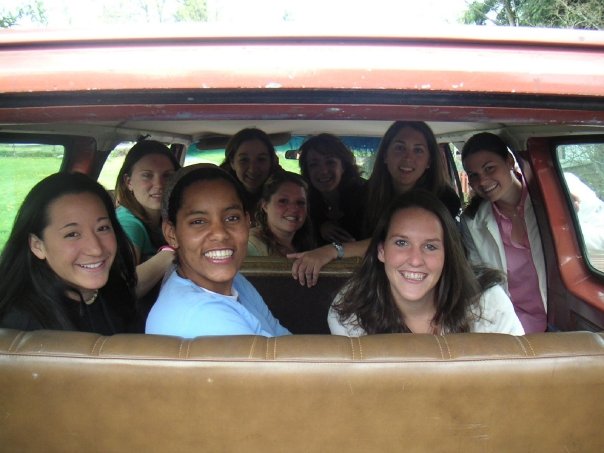
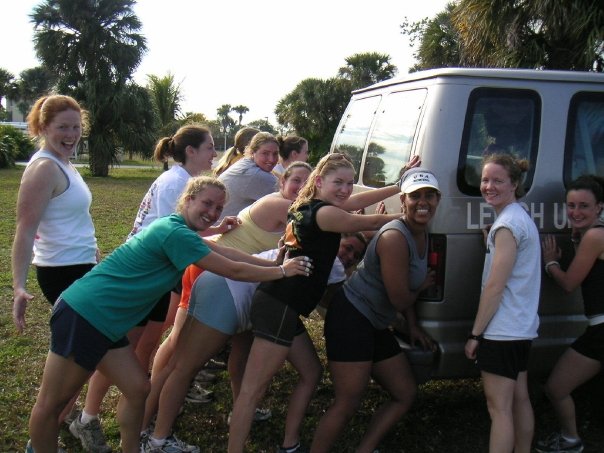
The challenge in terms of nutrition, of course, is that day trips and travel take you out of your kitchen, and away from familiar resources, foods and routine. This can absolutely cause stress and even have you questioning your ability to perform.
Did I eat too much… too little… WHY did I agree to that all you can eat buffet for dinner last night?!
To help answer your questions and feel confident during your next trip for rowing, I’ve teamed up with friend and fellow lightweight, Sydney Taylor. Sydney trains in Seattle with roots at Lincoln Park Boat Club in Chicago. She authors a food blog I love called Taylor in Your Kitchen, which features healthy recipes, seasonal foods and meals shared with family and friends. We collaborated this month to bring you tips and recipes designed for performance and travel, with various rowing scenarios in mind.
Scenario 1: Travel days by air or on the road
Both demand planning though air travel requires added creativity and skill. Choices are limited when flying and not all airports have what I would consider a reliable fallback option like Starbucks. Plus, we don’t usually load up our carry-on luggage with food in the same way we would with our cars!
Scenario 2: Training trips or race weekends away from home
Ask yourself:
Where are you staying, and will you have resources for food prep and storage?
Are you staying in a hotel? Does the hotel have a kitchen, kitchenette, mini-fridge or microwave?
Are you staying with a host family? Will you be able to use their kitchen? Will you feel comfortable using their kitchen?
Are you sharing a small space and resources (e.g., mini-fridge) with your teammates?
Also ask:
Will you have easy access to restaurants or grocery stores, and is there anything that makes sense to bring from home?
This second question might seem unusual up front but think of all the times you’ve had to rely on a designated team driver. If you’re in a city like Boston or Philadelphia, this is likely less relevant. It’s easy to get around by foot or public transportation, and grocery stores and restaurants abound. But, if you’re in the middle of a rural or suburban location, you’re likely dependent on whoever is driving the team bus or van.
Case in point: My training trip to Florida freshman year. We had a common space for eating that included a microwave but no refrigerator or stove. Plus, with the exception of a fruit stand and convenience store, there was no place within walking distance for groceries or food. I remember my teammates buying Styrofoam coolers for food storage but the setup was clearly less than ideal!
Scenario 3: Race days or regattas at home
Race days at home don’t necessarily bring travel to mind but similar strategies for planning and packing apply. With one or more races slated at most big events, this scenario requires a focus on timing, recovery and fuel.
Tips for Successful Travel
1. Do Your Research.
Take five minutes to learn about where you are going, where you are staying and the route you’ll be taking to get there. Check out the area around your hotel or host family, as well as the training location or race venue. If you’re in a position to chose where you stay, prioritize having a kitchen. Believe me, it’s worth it! You’ll save on buying groceries versus going out every meal, and have much more control of what you eat and how it’s prepared.
2. Be Proactive. Plan Ahead.
Make a list of what type of food items and meals you’ll need for the travel days, and the weekend or extended time away. Consider the preparation involved, as well as the items that make sense to pack versus buy at the planned destination. Think: buy meat and eggs; pack favorite spices. Similarly, be proactive! Calling your hotel or emailing your host family with questions can go a long way toward simplifying travel and facilitating ease of arrival.
For example, my host mom in Austin had no problem when I asked to ship an order of drink mix to her home – the simple request saved me from traveling with an extra 3-½ pounds! Similarly, I’ll always call ahead to the hotel that I’ve frequented in Canada and ask for a room with a microwave. Some of the rooms have them and some don’t, and frankly, microwaves are a big-ticket item when staying a week at a hotel. So why not call to sort out small details instead of making assumptions or dealing with surprise when you get there?
3. Get Creative, Get Cooking and Pack Like a Champion!
With research and planning in place, you know what you need to prepare and pack before leaving. Sydney’s provided us with some awesome recipe suggestions, including: Race Ready Granola, a Recovery Smoothie, Tuna Salad Two Ways, Panzanella, Poached Egg Recovery Feast, and Team Dinner/Crowd Pleaser Butternut Squash Lasagna.
Yes, she’s been busy in the kitchen!
Each recipe was designed with a specific purpose in mind, so please dive into and enjoy the descriptions. As for my advice: Invest in good Tupperware and cooler bags. Also, consider whether it makes sense to bring any of the following less traditional items for packing, all of which I’ve found useful on trips for rowing: hot plate, portable blender, travel mug, food scale or measuring cups, small strainer, can opener, set of utensils, small fry pan or pot, spatula, favorite spices or specialty items (e.g., cinnamon, chia seeds, flaxseed meal).
4. Think Flexible, Not Perfect.
Travel is unpredictable – that’s an understatement, in fact! And while I clearly believe in the value of planning, know that flexibility and forgiveness are just as important on the road. Remember your purpose (i.e., training, racing or both) and don’t get caught up in the details if, for example, you need to modify your favorite pre-workout meal.
Runner, Phoebe Wright, talks about this in a blog post called, The Art of Keeping the Main Things the Main Thing. Check it out and note the first item on her list of “things that aren’t the main thing!” It’s a fun read with advice that can easily carryover to your next trip for crew.
5. Have fun and ALWAYS Pack Snacks!
I increasingly catch myself reminding younger athletes to remember to have fun. And, honestly, I want to roll my eyes at myself every time I say or think of the words! But remember how I said that winter training trips were some of my favorite, most memorable times with Lehigh Crew?
I see so many athletes frustrated with their progress and preoccupied with erg scores, results, their seat in the boat or ranking on the team, and I get it. We’re athletes. We’re driven. Hard work and high standards describe who we are. But when stress or frustration takes hold, I fear that we lose an appreciation for the process and awareness of just how awesome it is to strive for our best through a sport.
Have fun on the water! Have fun with your teammates. Enjoy all the wonderful and awful times on the road. Because the time that your bus broke down on that random highway in Georgia… or the week that you survived on peanut butter, bananas and bread… those times are going to make for some pretty great memories later on – I promise!
Meet Taylor in Your Kitchen!
Sydney provided us with six awesome recipes I know I can’t wait to try! Please visit Taylor in Your Kitchen for additional photos that will walk you through the preparation for each snack and meal.
Race Ready Granola – serves 12+
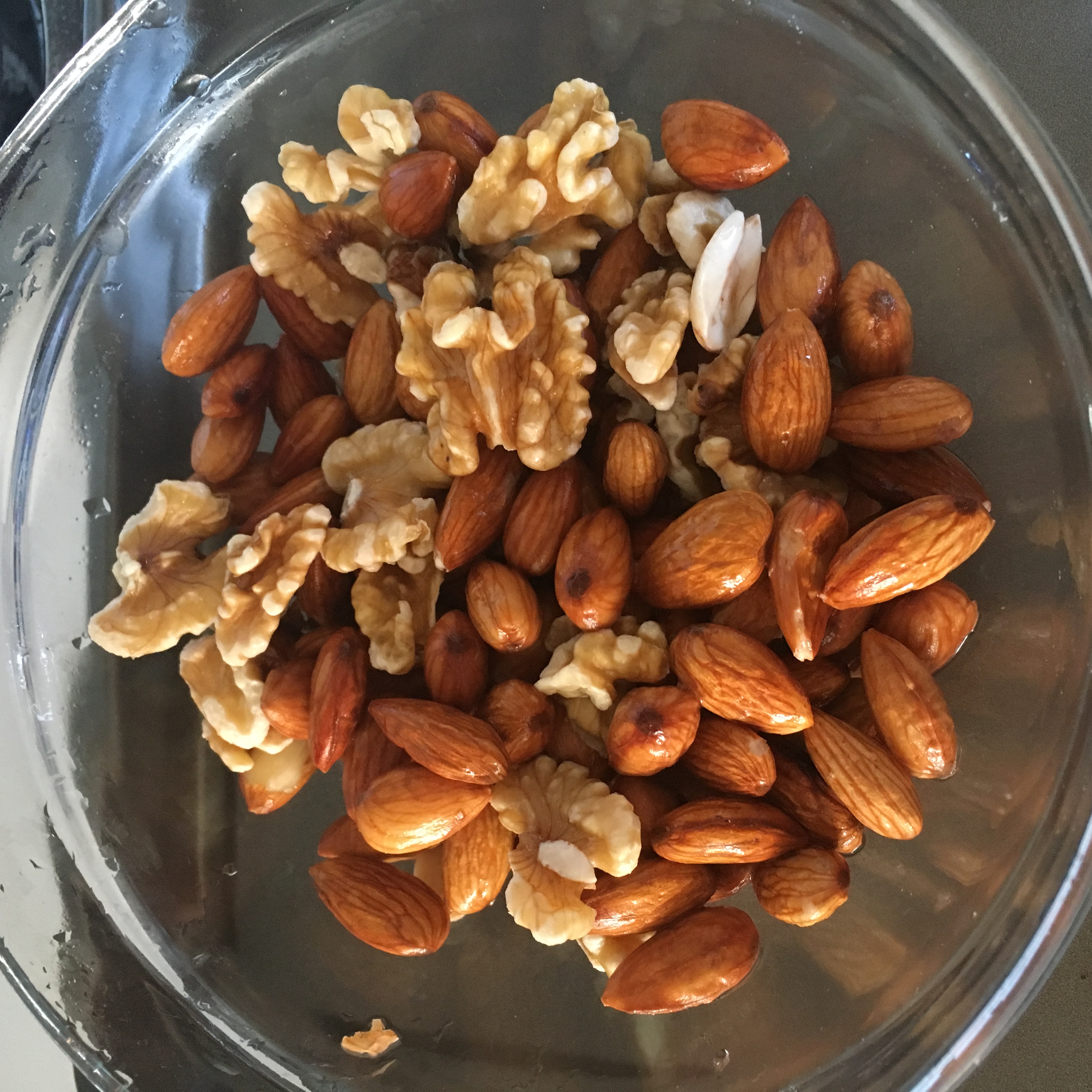
This recipe works great for race day because you can easily make the granola ahead of time and take it with you to the course. Feel free to play with your favorite flavor combinations to achieve your ideal granola. This granola recipe from A Traveling Wife is naturally grain-free and uses nuts as a base. I tweaked some ingredients to make my own favorite blend. You could add oats if you’d like but keep a closer eye on the oven to make sure they brown and don’t burn! This recipe works best with a food processor to chop the nuts and combine ingredients.
You will need:
1. food processor
2. 2 cups unsalted almonds
3. 1 cup unsalted walnuts
4. 1/2 cup unsweetened dried goji berries (or substitute dried cranberries, ginger or raisins)
5. 1/2 cup pitted dates
6. 1/2 cup raw sunflower seeds
7. 1/2 cup unsweetened shredded coconut
8. 1 t cinnamon
9. 1 t salt
10. 1 t ground ginger
11. about 2 t coconut oil
Steps:
1. Soak nuts in water for an hour. In a separate bowl, soak dried goji berries and dates in water for an hour.
2. Preheat oven to 250 degrees Fahrenheit.
3. After an hour, drain and rinse nuts.
4. Combine all ingredients in your food processor and pulse.
5. Spread coconut oil on a lined cookie sheet (we used parchment paper).
6. Spread granola mixture evenly across cookie sheet.
7. Bake for 60 minutes. Turn off heat and allow granola mixture to dry out in the oven for another 60 minutes.
8. Lift up corners of parchment paper for easy granola removal. Some granola may clump if not spread evenly, but it still tastes great!
9. Save any leftovers in an airtight container.
Recovery Smoothie – serves 2
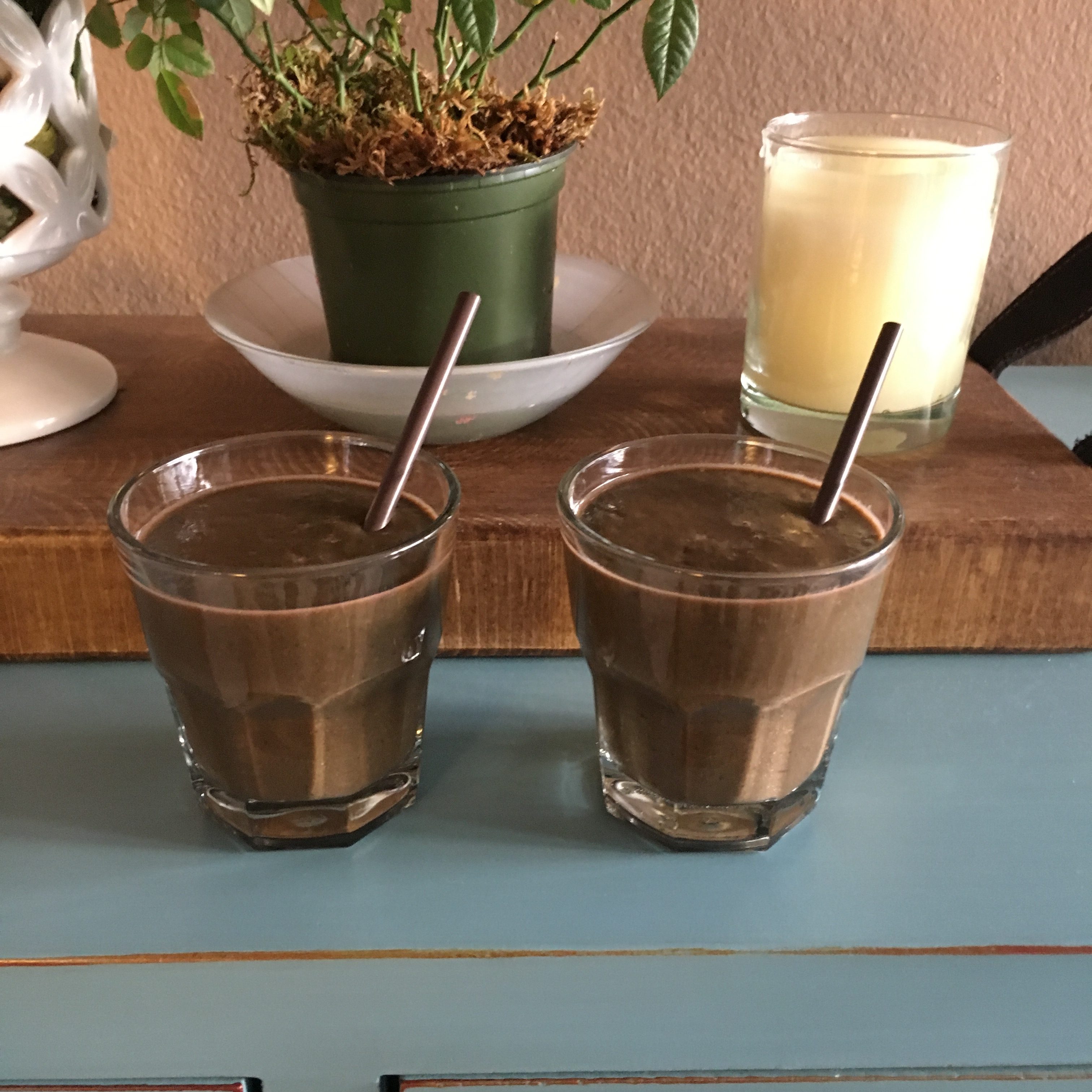
I love a smoothie for recovery after a hard effort and this is especially great in the summer months! Cool off, rehydrate and replenish with this nutrient-dense recovery powerhouse. Bonus: Alex thought it tasted like chocolate! Feel free to add your favorite protein powder (“original” or chocolate would taste especially nice) or have a protein-filled snack to round out this recovery meal.
You will need:
1. 1 T chia seeds, optional
2. 2 cups frozen spinach
3. 1/2 cup frozen pineapple
4. 1/2 cup frozen lingonberries (or frozen blackberries or raspberries)
5. 1/2 cup blueberries
6. 1 and 3/4 cup almond milk
7. 1/4 cup coffee
8. 1 t turmeric
9. 1 t cinnamon
10. 1 t coconut oil
11. 1 T almond butter
12. 4 small, steamed beets
Steps:
1. Set aside chia seeds in about 1/4 cup water while you prepare the rest of your ingredients.
2. Combine all ingredients in a powerful blender and combine until smooth – the Vitamix smoothie setting works wonders with this recipe!
3. Enjoy right away or store in the fridge for later consumption (beet juice may separate).
Tuna Salad Two Ways – serves 2
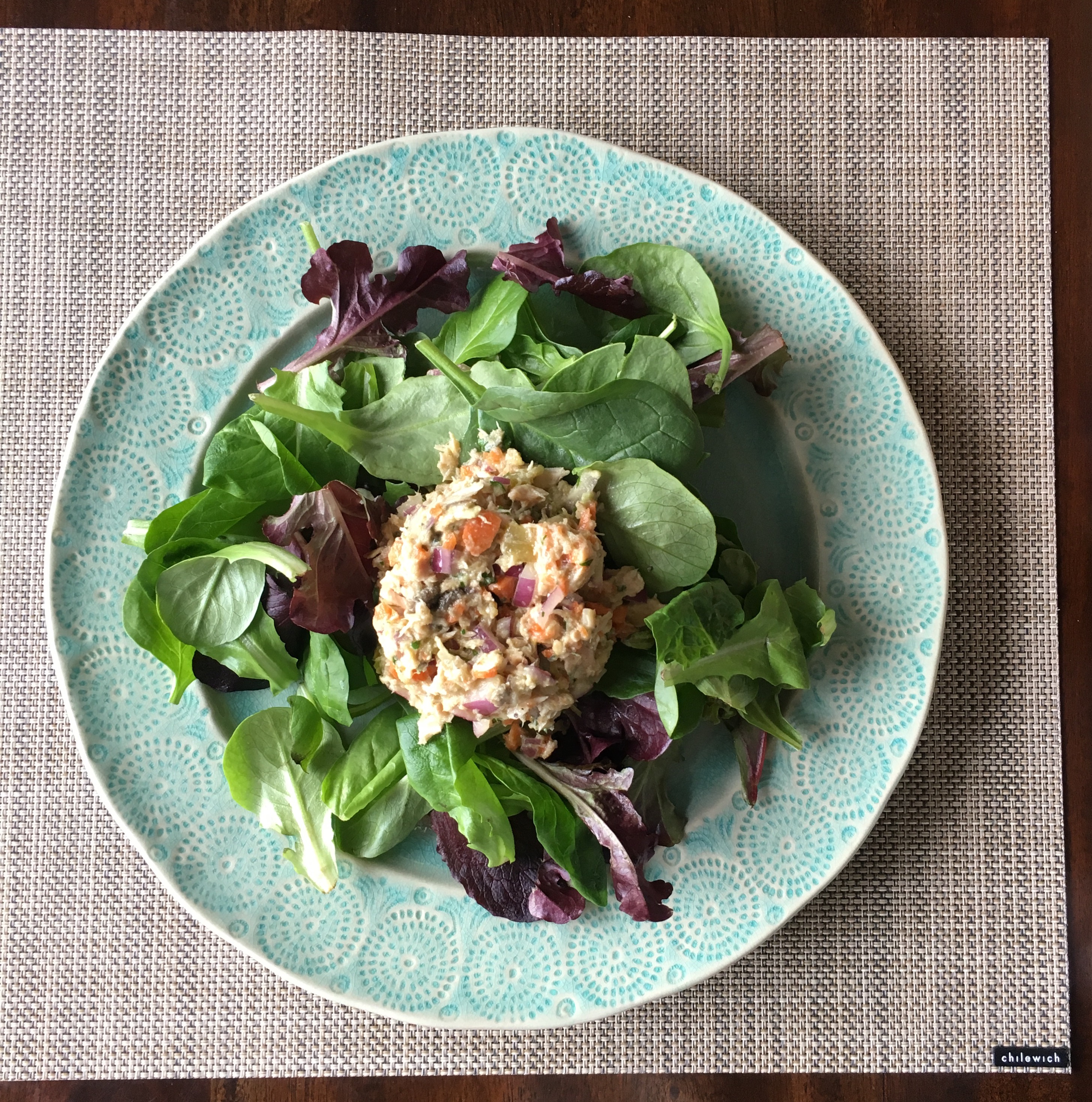
I was not a big tuna salad lover until last November when I branched out and tried a pre-packaged tuna salad snack – at the San Diego airport of all places! I had previously avoided tuna salads because they smelled fishy and I assumed they would taste fishy too. The San Diego salad was different because they mixed in diced green olives. I tested the tuna salad on crackers and continued to enjoy the tuna when my crackers ran out. More recently, my sister, Liz, forwarded me a recipe for tuna salad, and suggested I add another ingredient or two for more flavor (Simply Recipes Avocado Tuna Salad). I experimented with a diced green chile tuna salad and a green olive tuna salad, and will be hanging onto both options! I also like adding carrot if I do not have celery on hand.
You will need:
1. 5 oz canned tuna
2. 2-3 T diced olives or diced green chiles
3. 1/2 of an avocado
4. 1/4 cup diced red onion
5. 1/2 cup diced celery or carrot
6. 2 t lemon juice
7. 1 t lemon zest
8. 1 T olive oil
9. 2 T chopped cilantro
10. salt and pepper, to taste
Steps:
1. Combine all ingredients in a mixing bowl.
2. Serve on a bed of greens or a slice of toasted bread for a meal, or with crackers as a snack.
Panzanella/Pozanella – serves 2
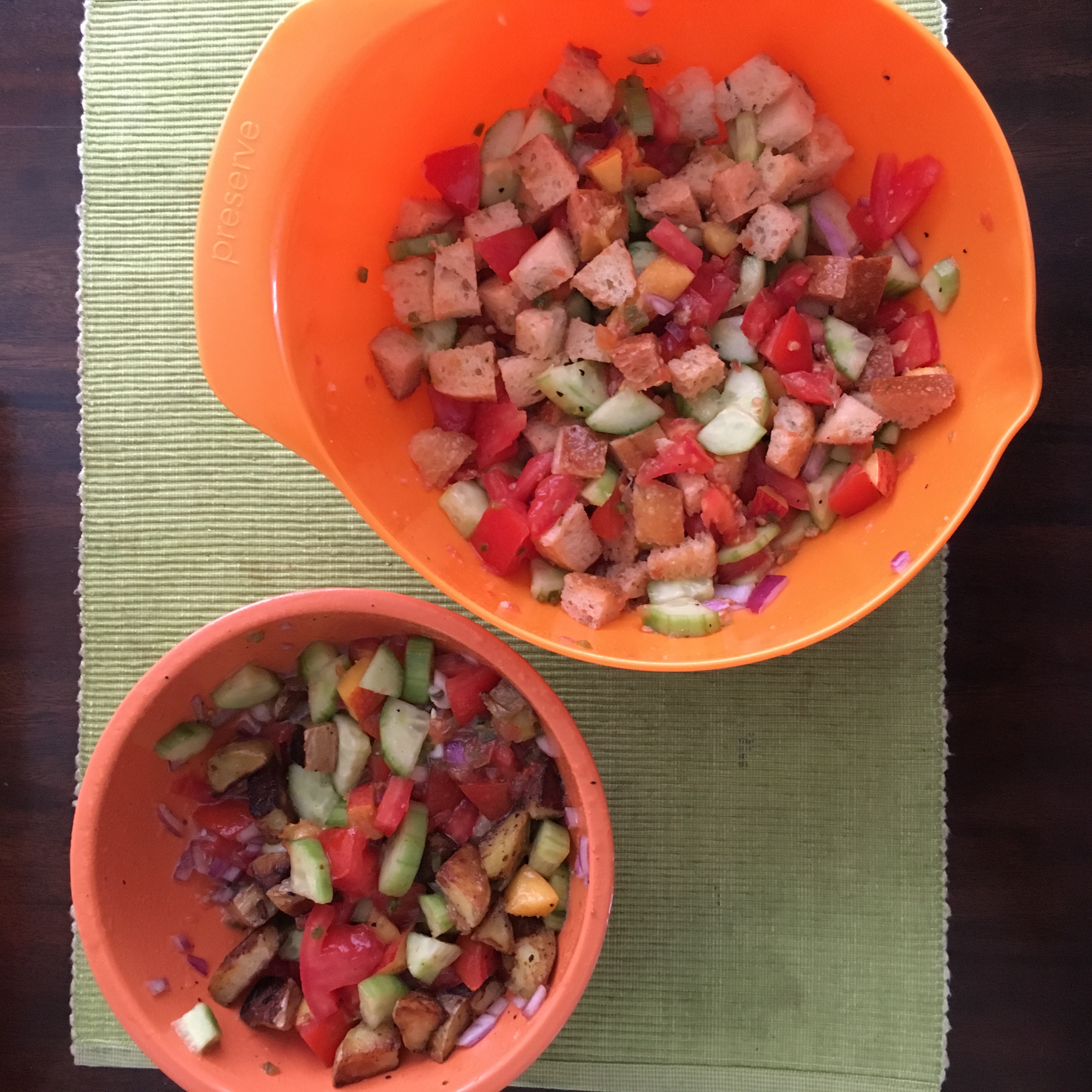
Panzanella is so easy to assemble and requires just one pan, and one burner or a hot plate. I made one serving of panzanella with two-day-old bread, as the original recipe called for, and a second serving with leftover breakfast potatoes to make it Whole30 compliant. Alex and I love this recipe served warm, especially when we add peach. The sweet, savory and spicy flavors marry nicely after a day spent in the fridge.
I adapted this recipe from my beloved “Good and Cheap” cookbook – you can find the recipe online as well: Spicy Panzanella. I have enjoyed many recipes from “Good and Cheap,” and encourage you to consider buying the cookbook or downloading a PDF copy. Visit Leanne Brown’s website to learn more.
You will need:
1. 1 large cucumber, peeled and chopped into quarters, then diced
2. 2-3 medium tomatoes, diced
3. 1 juicy peach or plum, chopped
4. salt and pepper
5. 2 slices day-old bread, or about 1/2 cup of roasted potatoes or breakfast potatoes
6. 1 jalapeño, finely chopped, with seeds removed for less spice
7. 2 T chopped tomato
8. juice of 1 lime
9. 2 T olive oil
Steps:
1. If you are using potatoes, roast bite-sized pieces in the oven first at 400 degrees Fahrenheit for about an hour.
2. Set aside 2 T of your diced tomatoes to use in the dressing. Combine chopped tomatoes and cucumbers in a large bowl. Sprinkle with salt and pepper and toss to combine (salt will bring out the tomato and cucumber juices). Set aside.
3. Heat a small saucepan over medium heat and add a drizzle of olive oil.
4. Sauté jalapeño for about one minute and then add your 2 tablespoons of diced tomato. Stir to combine, and keep cooking until tomato juice is released.
5. Sprinkle your dressing with salt and pepper, and cook until most of the liquid has evaporated. Turn off the heat and return your tomato and jalapeño to your cutting board.
6. Chop tomato and jalapeño as finely as possible and return to your pan with no heat. Add lime juice and 2 tablespoons of olive oil. Add salt and pepper to taste to finish off your dressing.
7. Add peach or plum to your cucumber and tomato mixture, followed by your dressing. Stir to coat.
8. If you are making one panzanella and one pozanella, prepare produce and dressing and then divide into two bowls before adding bread/potatoes. Add bread pieces or potatoes. Stir to coat bread/potato pieces. If you are using fresh bread, toast in the toaster or skillet for a minute or two before combining with your other ingredients.
9. Serve warm or cool, to your liking.
Poached Egg Recovery Feast – serves 1 or more

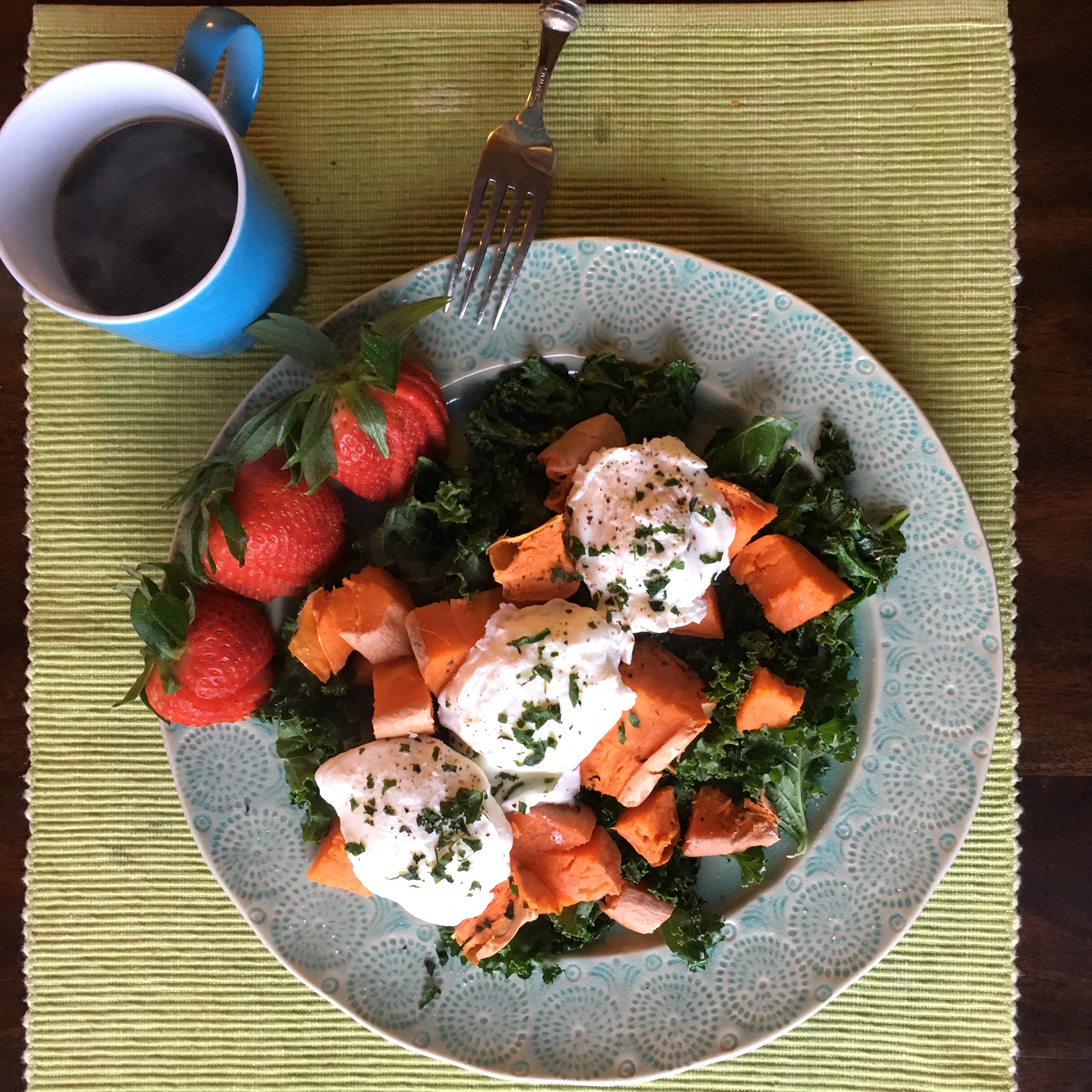
I love eggs any way after a long row but poached or hard-boiled eggs make for the easiest cleanup. On February 19th, an email came from Well & Good with the tagline “The no-fail trick to making a perfectly poached egg” and, as a newbie-poacher, I was immediately intrigued. Check out Well & Good’s article here. I keep a couple hard-boiled eggs on hand to round out a snack or add to add more protein to a salad, so I started poaching eggs for my breakfast for something different. This recipe requires one burner and one pot – your pot for poaching eggs will be much easier to clean than a scrambled egg pan and spatula! Finally, poached eggs taste best when they are served hot so make sure that the rest of your breakfast spread is ready to go before you start poaching eggs. It only takes about 3 to 4 minutes for eggs to poach – any longer and you will completely cook the yolk, which isn’t the goal. I like my eggs with a side of sweet potato to add extra carbs to my breakfast.
You will need:
1. sweet potato
2. 2 cups kale or other greens
3. 1-2 t coconut oil
4. 1/2 T apple cider vinegar or other vinegar (not red wine vinegar)
5. eggs (2 or 3 per person)
6. salt and pepper, to taste
7. about 1/2 t cinnamon
8. dried basil or parsley
9. 1/4 avocado per person
Steps:
1. Shortcut! Rinse your sweet potato and wrap in a wet paper towel. Poke several holes with a fork or knife. Microwave for 4-5 minutes and then flip over and microwave for another 1-2, depending on size of your sweet potato.
2. Heat 1 teaspoon oil over medium and sauté torn kale for about 5 minutes or until you reach desired crispiness. Set aside.
3. Heat a pot of water over high heat until just boiling. Turn heat down to about medium until you see a steady stream of champagne bubbles at the bottom of your pot. If your pot has bubbles that are not rising, you need more heat. Without a little bit of bubbles, your egg will sit at the bottom.
4. Stir vinegar into pot of water.
5. Crack an egg into a measuring cup and lower as close to the surface of your water as possible before pouring your egg into the pot. Egg whites will come together as the egg poaches.
6. Set a timer for 3 or 4 minutes and remove egg right away. Use a ladle for easy egg removal and set egg on a paper towel before plating.
7. Serve on a bed of greens or sautéed kale. Top with dried herbs if you have any on hand. Cut your microwaved sweet potato in half and drizzle with 1 t liquid coconut oil. Sprinkle with salt, pepper and cinnamon to taste. Add avocado to your meal for more satisfying, healthy fat.
Team Dinner/Crowd Pleaser Butternut Squash Lasagna – serves 6
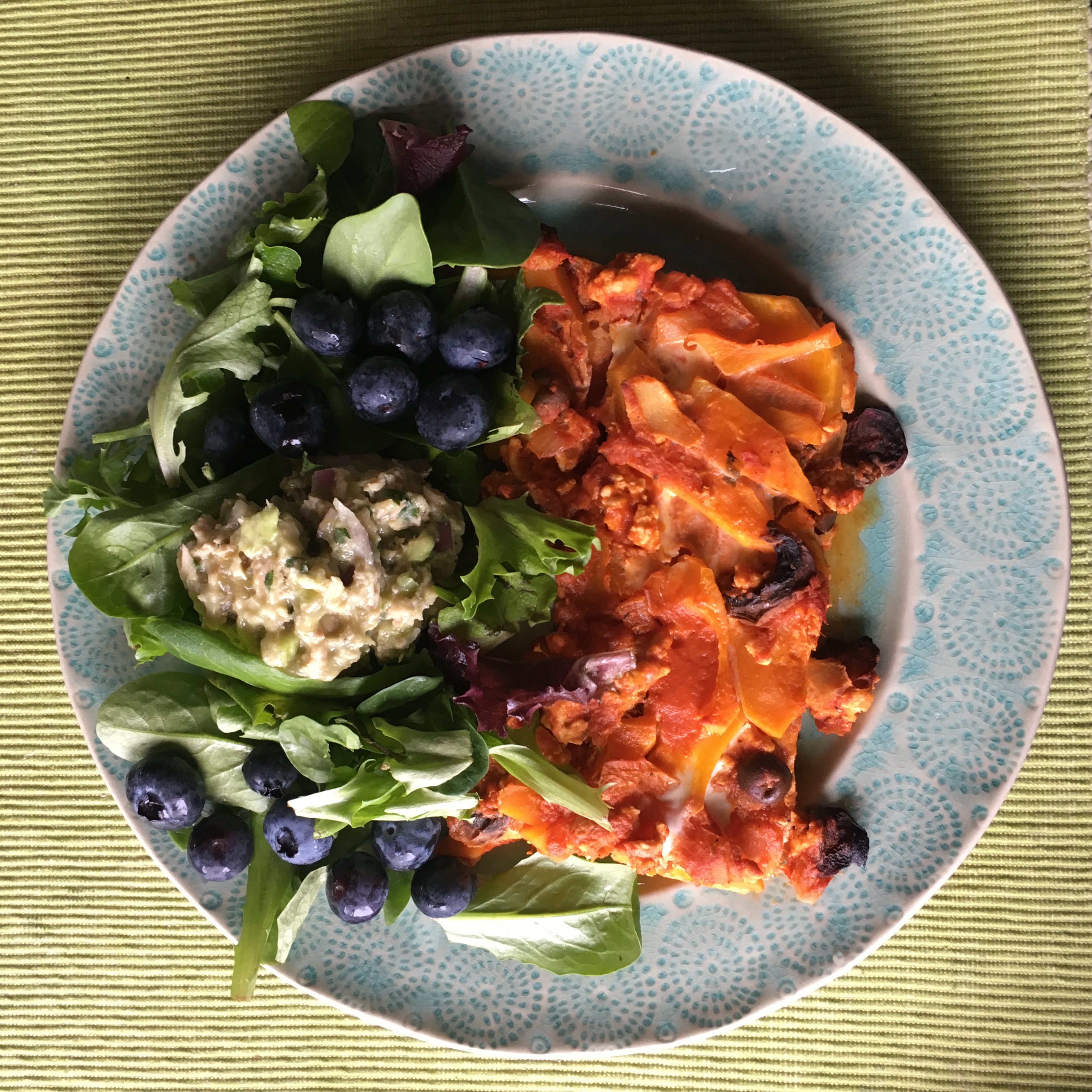
Lasagna is great if you have access to a kitchen while you are on the road. You will need one pot and one burner or hot plate, and an oven. I did not change this recipe much but am writing it out here to guide you through the butternut squash prep! I also added mushrooms to my meat sauce because we are big mushroom fans. You can find the original recipe on Stupid Easy Paleo.
You will need:
1. 2 medium butternut squash
2. 2 t coconut oil
3. 1 red or yellow onion, diced
4. 3-5 garlic cloves, minced
5. 1 lb ground chicken
6. 1 t dried oregano
7. 1/2 cup sliced green or black olives
8. 4 oz white mushrooms, sliced
9. 36 oz canned tomato sauce (Rao’s homemade tastes great)
10. 4 oz tomato paste
11. 4 eggs, beaten
12. salt and pepper to taste
Steps:
1. Preheat your oven to 400 degrees Fahrenheit.
2. Microwave butternut squash for two minutes, then flip and microwave again for two more minutes. This step will make it much easier to cut the squash.
3. Place a large pot for your meat sauce over medium heat. Add coconut oil and heat for about a minute before adding your chopped onion. Sauté onion for about 5 minutes, or until just translucent.
4. Add chicken, garlic and oregano and turn your heat up to medium-high. Stir to combine ingredients and sauté until chicken is completely cooked through.
5. Next, add olives, tomato paste, tomato sauce and mushrooms. Stir to combine and season with salt and pepper, to taste.
6. Let simmer over low heat while you chop butternut squash.
7. Your butternut squash should be a little easier to cut because of the microwave step. Cut the squash in sections about 3-4 inches wide, starting down from the stem. Peel your squash one section at a time using your knife, and then set that section on its side to cut into rounds (or hexagons) about 1/8 of an inch thick. You can find photos of this process in the gallery (above).
8. Beat together eggs and set aside.
9. In a lasagna pan (or two), start spreading out your first layer of butternut squash. Avoid overlapping squash pieces but try to fill the gaps as much as possible. The squash will act as your pasta layer. You may have to trim additional small pieces of squash to fill in the gaps. Next, spread about 1 cup of meat sauce evenly across the squash layer. Top with about 1/3 of your egg mixture. Repeat the squash-sauce-egg mixture until you run out of ingredients.
10. Bake for 25-30 minutes, until squash reaches desired tenderness.
Sources:
Bauer, Elise. “Avocado Tuna Salad Recipe.” Simply Recipes. N.p., n.d. Web. 01 Mar. 2017. (Tuna Salad)
Brown, Leanne. “Good And Cheap.” Good And Cheap. N.p., n.d. Web. 01 Mar. 2017. (Panzanella)
Gaudreau, Steph. “Butternut Squash Lasagna – Stupid Easy Paleo.” Stupid Easy Paleo. N.p., 27 Jan. 2017. Web. 01 Mar. 2017. (Lasagna)
Jenn. “Grain-free Granola [Whole30 and Paleo Friendly].” Grain-free Granola [Whole30 and Paleo Friendly]. N.p., 01 Jan. 1970. Web. 01 Mar. 2017. (Granola)
Siegel, Arianne. “The no-fail trick to making a perfectly poached egg.” Well Good. N.p., 24 Feb. 2017. Web. 01 Mar. 2017. (Poached Eggs)


Love the Team photos from Lehigh University and the great memories and experiences shared.
Excellent advice/guidance for all athletes….think flexible, adapt, have fun and put the right ‘fuel’ in your body…before competition and after!
Thanks for the fantastic recipes!!!
Thanks for the comment, Dad! Yes, many great memories from Lehigh Crew. Let me know if you try any of the new recipes 😀
Awesome blog! I so enjoy reading articles like this. Thanks a lot for posting!
Thanks for reading!